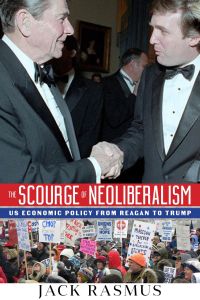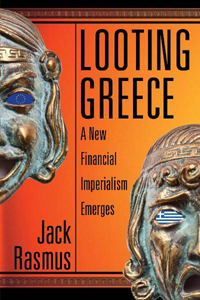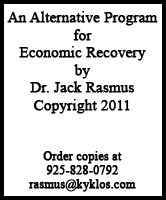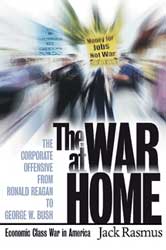by Dr. Jack Rasmus
April 22, 2024
This past weekend, April 20, 2024 the US House of Representatives passed a bill to provide Ukraine with another $61 billion in aid. The measure will quickly pass the Senate and be signed into law by Biden within days.
The funds, however, will make little difference to the outcome of the war on the ground as it appears most of the military hardware funded by the $61 billion has already been produced and much of it already shipped. Perhaps no more than $10 billion in additional new weapons and equipment will result from the latest $61 billion passed by Congress.
Subject to revision, initial reports of the composition of the $61 billion indicate $23.2 billion of it will go to pay US arms producers for weapons that have already been produced and delivered to Ukraine. Another $13.8 billion is earmarked to replace weapons from US military stocks that have been produced and are in the process of being shipped—but haven’t as yet—or are additional weapons still to be produced. The breakdown of this latter $13.8 amount is not yet clear in the initial reports. One might generously guess perhaps $10 billion at most represents weapons not yet produced, while $25-$30 billion represents weapons already shipped to Ukraine or in the current shipment pipeline.
In total, therefore, weapons already delivered to Ukraine, awaiting shipment, or yet to be produced amount to approximately $37 billion.
The remainder of the $61 billion includes $7.8 billion for financial assistance to Ukraine to pay for salaries of government employees through 2024. An additional $11.3 billion to finance current Pentagon operations in Ukraine—which sounds suspiciously like pay for US advisors, mercenaries, special ops, and US forces operating equipment like radars, advanced Patriot missile systems, etc. on the ground. Another $4.7 billion is for miscellaneous expenses, whatever that is.
In other words, only $13.8 billion of the $61 billion is for weapons Ukraine doesn’t already have!
And that $13.8 billion is all Ukraine will likely get in new weapons funding for the rest of 2024! Like the $23 billion already in theater, that will likely be burned up in a couple of weeks this summer once Russia’s coming major offensive—its largest of the war—is launched in late May or early June. So what does the US do in order to continue to fund Ukraine’s economy, government and military efforts this fall and thereafter?
In other words, what’s the Biden/NATO strategy for aiding Ukraine, militarily and economically, after the $37 billion is expended by late this summer? Where’s the money to come from?
To understand how the US/NATO plan to fund subsequent weapons production for Ukraine in late 2024 and early 2025, one must consider not only the $61 billion bill but a second bill also passed by Congress this past weekend that hasn’t been given much attention in the mainstream media.
That second bill may potentially provide up to $300 billion for Ukraine from USA and its G7 allies, especially NATO allies in Europe where reportedly $260 of the $300 billion resides in Eurozone banks.
Biden/US Short Term Strategy 2024
The $61 billion is clearly only a stopgap measure to try to get the Ukraine army and government funded through the summer. Beyond that, the broader Biden strategy is to keep Ukraine afloat until after the US November elections. In addition to the $61 billion—which the US hopes will get Ukraine through the US November election (but likely won’t)—US strategy includes getting the Russians to agree to begin some kind of negotiations. The US will then use the discussions to raise a demand to freeze military operations on both sides while negotiations are underway. But Biden’s ‘freeze and negotiate’ strategy is dead on arrival, since it is abundantly clear to the Russians it is basically about US and NATO ‘buying time’ and Russia has already been played by that one. As the popular US saying goes: “fool me once shame on you; fool me twice shame on me”.
The Russians already fell for that ‘let’s suspend fighting and negotiation ploy’ with the Minsk II treaty back in 2015-16. It agreed to halt military operations in the Donbass back then but NATO and the Ukraine government used the Minsk agreement as cover to re-build Ukraine’s military force which it thereafter used to attack the Donbass provinces. European leaders Angela Merkel of Germany and Francois Holland of France thereafter publicly admitted in 2022 that Minsk II was just to ‘buy time’.
The Russian’s were again similarly snookered at the Istanbul peace discussions held in April 2022. They were asked by NATO to show good faith in negotiations by withdrawing their forces from around Kiev, which they did. Negotiations were then broken off by Zelensky, on NATO’s strong recommendation, and Ukraine launched an offensive chasing the withdrawing Russians all the way back to the Donbass borders.
Russia is therefore extremely unlikely to fall a third time for a Biden/NATO request to ‘freeze’ military operations and negotiate again.
Biden may want to ‘buy time’ once more, but that hand’s been played twice already and the West will be (is being) told by Russia they aren’t interested in buying anything from the West and its ‘money’ no longer has any value.
Speaker Johnson’s Volte Face
The passage of the stop-gap $61 billion for Ukraine by the US House of Representatives was the result of House Speaker, Johnson, doing an about face and allowing the vote on the House floor after saying he wouldn’t for weeks. There’s been much speculation in the US mainstream media as to why Johnson reversed his position and allowed the Ukraine aid bill to the House floor for a vote. However, it’s not difficult to understand why he did reverse his view.
In recent weeks there was intense lobbying behind the scenes by US weapons companies with key Republican committee chairmen in the House. After all, at least $37 billion in payments for weapons—both already delivered and to be delivered—was involved. Not a minor sum even for super-profitable companies like Lockheed, Raytheon and the like. Rumors are that corporate lobbying had its desired effect on Republican committee chairs in the House, who then in turn pressured Johnson to allow the vote on the floor. The final vote in the House was 310 to 111 with 210 Democrats joining 100 Republicans to pass the measure—revealing that the core support for the US Military Industrial Complex in the House of Representatives is at least three-fourths (the US Senate likely even higher).
So the vote was the result of a ‘parliamentary maneuver’ in which all the Democrats crossed over to support the Republican Speaker of the House (who de factor switched parties for the moment). A minority of Republicans joined him. A slim majority of Republicans opposed the measure. Their opposition remains. Thus it is highly unlikely Congress will appropriate more funding for Ukraine for the rest of this year—even when the $61 billion for weapons and Ukraine’s government run out by this late summer.
So what happens if and when the $61 billion is exhausted well before the November elections?
A possible answer to that question lies in the passage of a second Ukraine funding measure this past weekend. The $61 billion was not the most important legislative action in the US House. While most of the media commentary has been on that Ukraine aid bill, hardly anything has been said in the mainstream media about another bill that the US House also passed over the weekend. This second measure has greater strategic implications for US global interests than the $37 billion in actual weapons shipments for Ukraine. This second measure is HR 8038, a 184 page bill misnamed the ‘21st Century Peace Through Strength Act’ which amounted to yet another package (the 16th?) of US sanctions.
Transferring Russia’s $300 Billion Assets to Ukraine
The first section of the bill arranges a procedure for the US to force the sale of the China company, Tik Tok, to a consortium of US financial investors, reportedly led by former US Treasury Secretary under Trump, Steve Mnuchin. This is part of the expanding list of sanctions on China. Also sanctioned are China purchases of Iranian oil, as well as a host of additional sanctions on Iran itself. However the most significant measure related to sanctions on Russia.
The 21st Century Peace Through Strength Act calls for the US to transfer its $5 billion share of Russia’s $300 billion of seized assets in western banks that were frozen in 2022 at the outset of the Ukraine war. It provides a procedure to hand over the $5 billion to Ukraine to further finance its war efforts! This move has been rumored and debated in the USA and Europe since the assets were seized two years ago. But now the process of actually transferring the seized funds to Ukraine has begun with the passage of this second bill by the US House.
The USA’s $5 billion share in US banks is just a drop in the bucket of the $300 billion. Russia could probably care less about it, i.e. a mere ‘rounding error’ in its total revenue from sale of oil, gas and other commodities. But Europe holds $260 of the $300 billion, according to European Central Bank chair, Christine LaGarde. A tidy sum which Russia has threatened to retaliate against Europe should the EU follow the US/Biden lead and also begin to transfer its $260 billion to Ukraine.
The US bill is very clear that the transfer of the US’s $5 billion is imminent. The bill requires the Biden administration to establish a ‘Ukraine Defense Fund’ into which the US’s $5 billion will be deposited. If parts of the $5 billion are not in liquid asset form, the US president is further authorized by the bill to liquidate those assets and deposit the proceeds in the fund as well. So the seizure and transfer of the $5 billion to Ukraine is a done deal. And when it happens a legal precedent will be made that Europe may use to follow and transfer its $260 billion.
One can expect the US to pressure Europe strongly to do so. Biden is further authorized by the bill to ‘negotiate’ with Europe and other G7 partners to convince them to do the same—i.e. seize their share of the $300 billion, liquidate and then transfer the cash assets into the US ‘Ukraine Defense Fund’. And to date the US has been able to ‘convince’ Europe—via its control of NATO and influence over Europe’s economy and its umbrella political elites in the European Commission and European Parliament—to follow US policy without too much resistance.
Europe is fast becoming an economic satrapy and political dependency of the USA in recent decades, more than willing to bend in whatever policy direction the USA wants.
It is clear the seizure & redistribution to Ukraine of the $300 billion via the Ukraine Defense Fund is the means by which the US/NATO plan longer term to continue to finance the Ukraine war after the $61 billion runs out sometime in 2024; and certainly in 2025 and beyond. For the US has no intention of ending its NATO led proxy war in Ukraine anytime soon. It is just seeking to ‘buy time’ in the interim before its November elections.
For a majority of both parties in the US—Democrat and Republican—are united on continuing the war. It will matter little who wins the presidency or which party has majorities in Congress after November. Political elites on both sides of the aisle in Congress are united in pursuing the war in Ukraine—just as they are united in continuing to fund Israel as well as to continue the US’s steadily expanding economic war with China. In just the past week it is obvious more US sanctions on China are also coming soon, including possibly an announcements of financial sanctions on China for the first time after US Secretary of State, Blinken’s, most recent visit.
Failed Russian Sanctions: Past and Future
The geopolitical objectives of the US and its commitment to continuing its three wars are resulting in unintended, negative effects on the economies of the US and its G7 allies, especially Germany. But those same sanctions have had little to no negative impact on Russia’s economy.
The recently passed US transfer of its $5 billion share of Russia’s $300 billion will accelerate the negative consequences especially for Europe should the latter follow the US lead and distribute its $260 billion share to Ukraine, which it eventually will.
As EBC chairperson, Lagarde, put it referring to the US plan and legislation: “It needs to be carefully considered”. UK political leaders are already on record advocating the confiscation and transferring of Europe’s $260 billion holdings of Russian assets to Ukraine. Europe in recent years has a strong history of capitulating to US economic policies and demands. It will be no different this time.
Should Europe join the USA in transferring its $260 billion share of Russian assets in European banks (most of which is in Belgium), it’s almost certain that Russia will reply similarly and seize at least an equal amount of European assets still in Russia. The Russian Parliament has officially recently said as much.
Part of the G7/NATO sanctions to date included forcing western businesses in Russia to liquidate and leave Russia. Some have done so. But many have not. Russia’s response has been to arrange the transfer of those EU companies’ assets that have left to Russian companies. This has actually stimulated the Russian economy. It resulted in Russian government subsidies—and thus government spending—to Russian companies assuming the assets, as well as additional investment by those companies after their acquisition of the departed EU companies’ assets.
In short, western sanctions measure pressuring western companies to leave Russia has backfired in its predicted result of reducing Russian government spending and business investment.
In contrast, the US/NATO’s fifteen or so sanctions packages to date have had little, if any, impact on Russia’s economy since the commencing of the war in February 2022. To cite just a few of the performance of Russia’s key economic indicators under the sanctions regime: (Note: all following data is from the US global research source https://tradingeconomics.com ):
Russia’s GDP in the latest six months has risen between 4.9% (3rd quarter 2023) to 5.5% (4th quarter). Russia’s PMI statistics show robust expansion for both manufacturing and services during the same period while in most of the major European economies both PMI indicators are contracting. Wage growth in Russia over the six months has averaged 8.5% for both quarters (whereas in the US is it less than half that and in Germany less than 1%).
Russian government revenues rose from roughly 5 trillion rubles in the third quarter to 8.7 trillion in the 4th. Military expenditures are up from $69.5 billion (dollars) to $86.3 billion. Consumer spending is at record levels in the latest quarter. Russian household debt as a percent of GDP remains steady at around 22% (whereas in the USA it is 62.5%). Crude oil production and general exports continue to steadily rise. Gasoline remains at 60 cents a liter (whereas in US five-six times that and in Europe more than ten times). And the unemployment rate in Russia remains steady at 2.9% (whereas in the US and Europe it’s a quarter to a half higher). Interest rates and inflation are higher in Russia but that represents an economy firing on all economic cylinders and is not necessarily a negative.
In short, it’s hard to find a single statistic that shows the Russian economy has been negatively impacted by the US/NATO sanctions regime over the past two years. Indeed, an argument can even be made the sanctions have stimulated the Russian economy not undermined it.
The latest sanction in the form of the US and G7 transfer of the $300 billion in seized Russian assets in western banks will almost for certain have a similar effect on Russia’s economy. Namely, distributing the $300 billion will result in Russian government seizure of at least an equivalent of European companies’ assets still in Russia. And that will provide funding for still further government subsidy spending benefiting Russian companies followed by more private investment.
Is the US Empire Shooting Itself in the Foot?
But there is an even greater consequence to follow the US and Europe’s desperate act of transferring Russia’s $300 billion in assets in western banks to Ukraine.
Western bankers, economic policymakers, and many economists alike have warned against the seizure and transfer of the $300 billion. Heads of US and other central banks, CEOs of large commercial banks, and even mainstream economists like Shiller at Yale have continually warned publicly that transferring the assets will seriously undermine faith in the US dollar system which is the lynchpin of the US global economic empire.
What countries in the global South will now want to put (or leave) their assets in western banks, especially in Europe, if they think the assets could be seized should they disagree on policies promoted by the empire? It’s clear the US has now begun to impose ‘secondary’ sanctions on countries that don’t abide by its primary sanctions on Russia. Will the US also seize the assets of these ‘secondary’ countries now in western banks if they don’t go along with refusing to trade with Russia? And what about China, as the US has now begun to expand its sanctions—primary and secondary—on that country as well? Watch for unprecedented financial sanctions on China that may be forthcoming following Blinken’s visit to China this week.
The US does not realize this is not the 1980s. The global south has developed massively in recent decades. They are insisting on more independence and more say in the rules of the empire—without which they will simply leave now that an alternative is beginning to appear in the expansion of the BRICS countries.
Recently expanded to 10 members (all of which in the middle east and heavily oil producers), no fewer than 34 more countries have now petitioned to join the BRICS. Furthermore, it is reported that at the BRICS next conference in late 2024 an ‘alternative global financial framework’ will be announced! That will likely include some alternative currency arrangement as well as an alternative international payments system to replace the US SWIFT system (by which the USA via its banks can see who is violating its sanctions). Likely forthcoming will be something to replace the US-run IMF in order to ensure currency stability and an expansion of China’s Belt & Road as an alternative to the US run World Bank. (Perhaps that is the real topic of Blinken’s forthcoming China visit?)
In short, the US global economic empire is entering its most unstable period. And yet US policy is to accelerate alternatives to it by seizing and transferring funds to Ukraine to continue the war! The blowback from the seizure and transfer will prove significant, both to US and European interests. It will render past resistance to US sanctions pale in comparison.
How to Crash an Empire!
History will show that US geopolitical objectives and strategies in the 21st century were the single greatest cause of the decline of US global economic hegemony over the last quarter century. Much of those objectives and strategies have been the work of the most economically ignorant foreign policy team in US history, who are generally referred to as the Neocons.
The seizure and transfer of the $300 billion may provide a way to continue funding Ukraine in the US/NATO proxy war against Russia through 2024 and beyond. But the timing could not be worse for US/Europe imperial interests, coming on the eve of the historic BRICS conference later this year. The desperate act of seizure and transfer will only convince more countries of the global South to seek another more independent alternative by joining the BRICS, or increasingly trade with that bloc.
History shows empires rest ultimately on economic foundations. And they collapse when those underlying economic foundations fracture and then crumble.
The longer run consequence of the $300 billion transfer and the exiting of the global South from the US empire can only be the decline in the use of the US dollar in global transactions and as a reserve currency. That sets in motion a series of events that in turn undermine the US domestic economy in turn: Less demand for the dollar results in a fall in the dollar’s value. That means less recycling of dollars back to the US, resulting in less purchases of US Treasuries from the Federal Reserve, which in turn will require the Fed to raise long term interest rates for years to come in order to cover rising US budget deficits. All this will happen to an intensifying fiscal crisis of the US state rapidly deteriorating already.
In other words, blowback on the US economy from declining US global hegemony—exacerbated by sanctions in general and seizure of countries like Russia’s assets in particular—is almost certain in the longer run, just as it will be for Europe’s economy in the even more immediate term.
But such is the economic myopia of the US neocons and the incompetent political elite leadership in both parties in the USA in recent years. As that other American saying goes: ‘We have found the enemy and they are us!’
Dr. Jack Rasmus
April 22, 2024
 Dr. Jack Rasmus @drjackrasmus
Dr. Jack Rasmus @drjackrasmus








